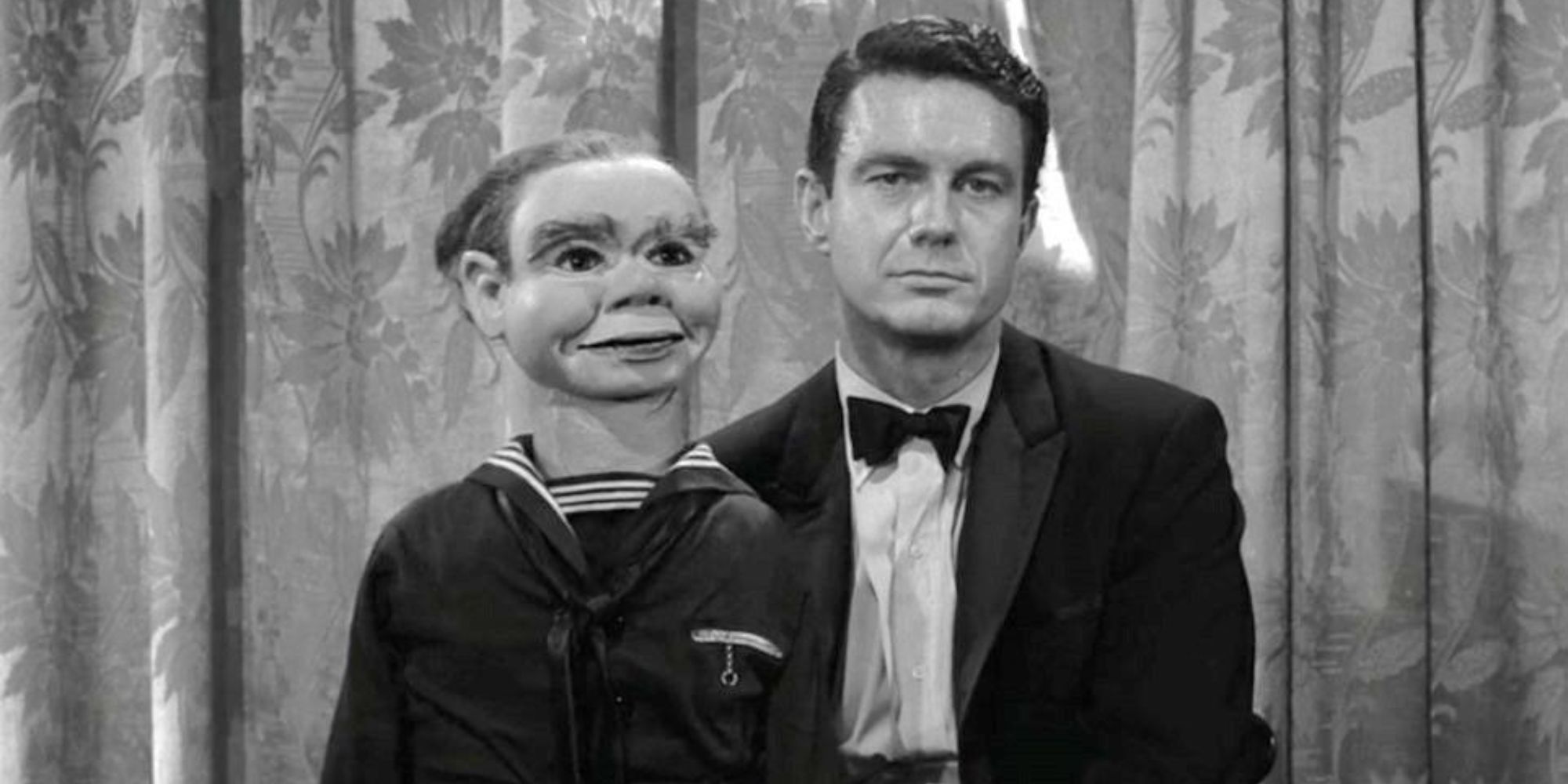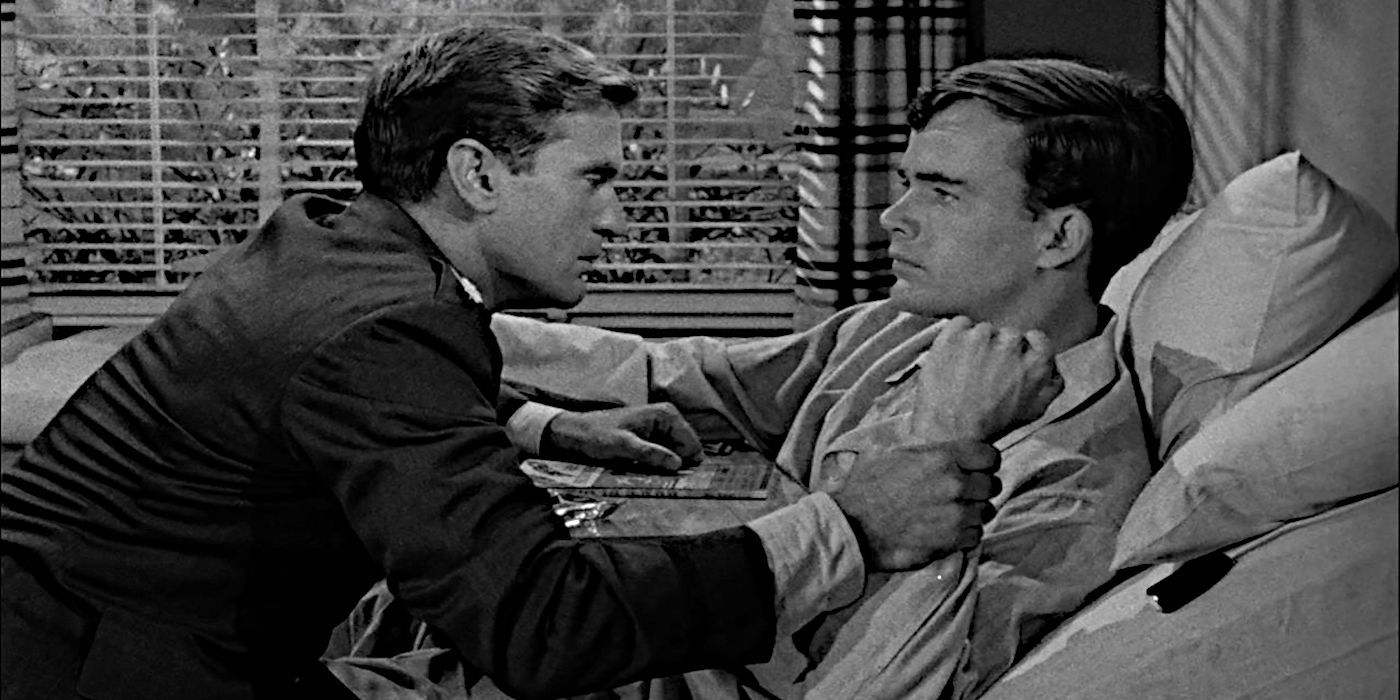A genre-defining anthology series, Rod Serling'sThe Twilight Zone melded science fiction, horror, and suspense into a thought-provoking examination of society’s darker inclinations. The Twilight Zone is synonymous with masterful storytelling, recognized as such by multiple generations who each make an updated version of their own.
Although there are episodes of The Twilight Zone that are humorous, the widely remembered entries were the ones that left a feeling of unease in the viewer. Serving as examples of the series at its finest, the following episodes are some of the most disturbing stories of the legendary show.

Your changes have been saved
The Twilight Zone (1959)
Release Date October 2, 1959
Creator Rod Serling
Main Genre Sci-Fi
Seasons 5
10 “Twenty Two”
Season 2, Episode 17
 Image via CBS
Image via CBS A dancer (Barbara Nichols) hospitalized for work-related stress is plagued with vivid nightmares about a nurse who beckons her to enter room 22, the morgue, by saying, “Room for one more, honey.” Her doctor is convinced there’s nothing wrong with her, but the dancer swears the nightly encounter with the creepy nurse are real. When she later attempts to embark on a trip, her nightmares prove to be closer to reality than even she anticipated.
An unfortunate and short-lived decision to shoot on video over film severely hurts the visuals for the episode, but the story is haunting enough to make up for the cost-cutting efforts. “Twenty Two” is one of the more traditionally horror-focused episodes of The Twilight Zone that revisits a running theme of the protagonist being marginalized by society for what they believe—often forced to operate in isolation. If the picture quality was up to the series’ normal standard, the episode could possibly be remembered as one of the strongest.
9 “The Dummy”
Season 3, Episode 33
 Image via CBS
Image via CBS A floundering ventriloquist, Jerry (Cliff Robertson), is having problems with his silent partner in “The Dummy.” Much to the irritation of his suffering agent, Jerry insists that his dummy, Willy, is alive and moving on his own free will—even going so far as to bite him after a show. Jerry’s solution is to switch dummies and create a new act, but he finds it harder than expected to move on when he can’t get his old partner’s voice out of his head.
The brilliance of “The Dummy” partially rests on the audience not being entirely sure if Willy is alive or if Jerry is suffering from delusions. As the camera angles shift off kilter to represent Jerry’s further descent into madness, one can only assume the dummy is an extension of Jerry’s fractured psychosis, but that would be too simple of an explanation. While the episode may seem standard by comparison to today’s blood-thirsty killer dolls like Chucky, the final reveal will leave an unsettling image to be remembered.
8 “The After Hours”
Season1, Episode 34
 Image via CBS
Image via CBS “The After Hours” sees a woman’s visit to a department store go horribly awry when she’s taken to a seemingly abandoned floor. Marsha White (Anne Francis) is looking for a gold thimble as a gift for her mother, but what she finds is horror when she’s taken to a floor that doesn’t exist and helped by a sales assistant who turns out to be a mannequin. When Marsha is accidentally trapped in the store after it closes, she’ll be faced with an unexplainable threat to her sanity.
The episode has a dreamlike quality as Marsha encounters odd, almost combative “employees” at the department store. As events progress in “The After Hours,” a claustrophobic unease sets in, further escalated by the surrounding mannequins who seem to know Marsha very well. The panning shot of the mannequins all slowly coming to life around Marsha is simple but still disturbingly effective as the frightened customer remembers the truth.
7 “Eye of the Beholder”
Season 2, Episode 6
 Image via CBS
Image via CBS One of the most iconic episodes of The Twilight Zone is also the most disturbing when the concept of beauty is examined in “Eye of the Beholder.” A patient with a bandaged face lies distraught in a hospital bed, worried that the newest experimental surgery will not fix her disfigured face and lead to her expulsion from society. The hospital staff are kind at the bedside, but privately, they too, find the patient’s predicament repulsive and beyond saving. Hoping for the best but expecting the worst, the bandages will be taken off to reveal an unexpected reality viewers aren’t prepared for.
For a story about appealing aesthetics, the audience is carefully restricted from seeing much of what is happening, leading to non-traditional shots that create a feeling of imbalance. Even though the hospital appears to be by all accounts normal, viewers will instinctually feel something is being hidden from them—there is reason to distrust the normalcy. Masterfully shot with a payoff that couldn’t have been predicted on first airing, “Eye of the Beholder” is easily one of the greatest episodes of the series.
6 “To Serve Man”
Season 3, Episode 24
 Image via CBS
Image via CBS The arrival of alien visitors, the Kanamits, brings with it the promise of peace and diplomacy to Earth. Although the Kanamits look imposing, Earth’s leaders are put at ease with the promise of new technologies that could cure starvation and all manner of long-standing issues. Meanwhile, a book left behind by the aliens becomes a new project for government code-breakers who seek insight into their new visitors' plans before it’s too late.
Not every episode could have a twist ending, especially not one as sinister as the one in “To Serve Man,” but when done successfully, they would be a trademark of the series. It’s an episode so calm and hopeful that when the twist does strike, you’ll want to immediately watch it again to look for the clues to the alien’s plan. It’s impressive how perfectly plotted the episode is, properly building suspense with just enough hint of danger to create a pit in the viewer’s stomach before their suspicions are confirmed.
5 “Living Doll”
Season 5, Episode 6
 Image via CBS
Image via CBS “Living Doll” is one of the episodes people think of when The Twilight Zone is mentioned. When a young girl comes home with a new toy, a Talking Tina doll, her stepfather Erich (Telly Savalas) immediately dislikes it. The doll feels the same way as she begins to taunt and threaten the bewildered man, saying things like, “My name is Talking Tina, and I’m beginning to hate you.” Initially, the stepfather thinks the doll is part of a practical joke, but he soon learns the doll’s threats are anything but.
The best episodes of The Twilight Zone capture a sense of magical menace, blending horror into the benign. Savalas’ subtle performance as the petty and quick-tempered stepfather elevates the story by grounding the escalating battle between man and doll. The narrative puts viewers in a conundrum, forcing them to decide if they should root for the bullish stepfather or the killer doll—a choice not many shows offer their audience.
4 “It’s a Good Life”
Season 3, Episode 8
 Image via CBS Production
Image via CBS Production Six-year-old Anthony Fremont (Billy Mumy) can read minds, create anything from existence, and uses those gofts to terrorize a helpless town in a legendary episode of The Twilight Zone. Everyone near Anthony needs to have happy thoughts because anything less will cause the powerful boy to transform them into a monster or wish them out of existence. Fantastic performances from the cast, including Cloris Leachman as Anthony’s mom, give viewers a brief taste of the constant state of tension that the town lives in.
One of the most effective tropes of horror is an evil child, so The Twilight Zone decided to up the ante by giving the child in question infinite power. “It’s a Good Life” takes perfect advantage of the anthology format, trimming unneeded explanations as to how the situation came to be. Regardless of why Anthony has his powers, the town continues to suffer with fake smiles under the threat of a mad god. The episode was one of the few to be remade for Twilight Zone: The Movie and directed by Gremlins’ Joe Dante.
3 “Night Call”
Season 5, Episode 13
 Image via CBS
Image via CBS An elderly woman lives alone with her only interaction in the form of a visiting caretaker to see after her needs. When she begins to receive cryptic and eerie calls in the middle of the night, she demands to find out who is behind the mysteriously haunting voice. Although she’s told by the phone company the line in question was disconnected, the woman will find out the source of the call is a truth she’s not ready to accept.
There’s an effort to tack a morality lesson onto “Night Call,” but the episode is best viewed as a lean and effective horror tale. The progression of the story builds slowly, with each phone call the next step in understanding the disturbing reason for the call. The centerpiece of the episode is the voice on the other end of the line, perfectly used to send a chill along your skin no matter how many times the episode is viewed.
2 “And When the Sky Was Opened”
Season 1, Episode 11
 Image via CBS
Image via CBS An astronaut questions his own existence when the world around him rejects the notion in “And When the Sky Was Opened.” It’s time for celebration when three returning astronauts land after a successful mission, but inexplicably each man begins to disappear along with everyone’s memory of them. Only one colonel remembers his fellow crewmen, and as he begs people to remember who he traveled with, he realizes the same will happen to him as well.
There’s a hopeless dread that consumes the episode, with no explanation for why the men cease to exist. There’s no evil entity to fight or greater power to bargain with, so there’s nothing the men can do other than wait for their turn to no longer exist. What adds to the despair is that, when taking into account the human need to be remembered, seeing a scenario where a life not only ends but never existed at all seems like a fate worse than death.
1 “The Encounter”
Season 5, Episode 31
 Image via CBS
Image via CBS As the only episode to be temporarily banned from airing in syndication, “The Encounter” was one of the most controversial and disturbing episodes of the series. “The Encounter” tells the story of two strangers, one Japanese American (George Takei) and the other American (Neville Brown), trapped in an attic while the proximity of a nearby katana sword with a curse left unfinished causes the owner of the antique to share shameful secrets about their involvement in World War II.
The use of racism and xenophobia to fuel the conflict between the two trapped men makes it an uncomfortable watch now, so one can only speculate on what it was like to watch the episode when it originally aired. The story ends with such an abruptly violent conclusion that it seems almost surreal while it’s happening—leaving the viewer shocked at how quickly civil pretenses could fall apart.
The Twilight Zone can be streamed on Paramount+ in the U.S.
Keep Reading: 'The Twilight Zone's 10 Most Famous Episodes, Ranked









 English (US) ·
English (US) ·